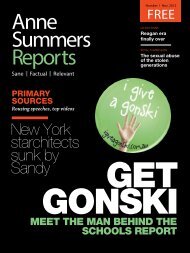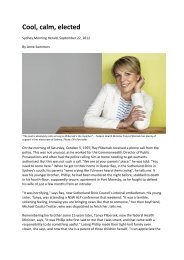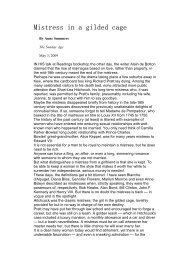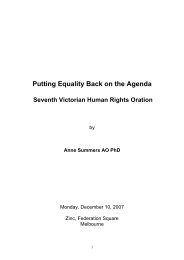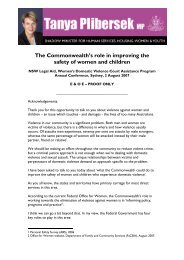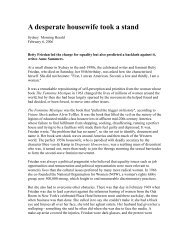beauty and desire in edo period japan & read my lips
beauty and desire in edo period japan & read my lips
beauty and desire in edo period japan & read my lips
You also want an ePaper? Increase the reach of your titles
YUMPU automatically turns print PDFs into web optimized ePapers that Google loves.
BEAUTY AND DESIRE<br />
IN Edo Period Japan<br />
&<br />
Read My Lips<br />
Jenny Holzer, Barbara Kruger, C<strong>in</strong>dy Sherman<br />
Exhibitions Open<strong>in</strong>g<br />
by<br />
Anne Summers<br />
National Gallery of Australia<br />
Canberra<br />
Friday June 6, 1998
Brian Kennedy<br />
Barbara Kruger <strong>and</strong> other Dist<strong>in</strong>guished Guests<br />
Ladies <strong>and</strong> Gentlemen<br />
I am very happy to have been <strong>in</strong>vited here this even<strong>in</strong>g to<br />
take up the considerable challenge of open<strong>in</strong>g these two<br />
very special <strong>and</strong> unique exhibitions.<br />
I call it a challenge because at first sight the two exhibitions<br />
seem so different that one wonders how they might be talked<br />
about together.<br />
After all, what can we say that might l<strong>in</strong>k the artistic output of<br />
17 th century Tokyo with the work of three women work<strong>in</strong>g <strong>in</strong><br />
late 20 th century Manhattan, work<strong>in</strong>g <strong>in</strong>dividually, <strong>and</strong> us<strong>in</strong>g<br />
mostly contemporary media, who seek to comment on <strong>and</strong><br />
criticise some of the most powerful images of our time?<br />
Is there any complementarity between them, or should they<br />
be regarded as parallel experiences?<br />
It will be up to those who visit the exhibitions to draw their<br />
own conclusions but let me say this:<br />
I did not expect to f<strong>in</strong>d more than parallels, especially when I<br />
realised that the Japanese exhibit was not entirely focused<br />
on women (after all, I do not believe I am here this even<strong>in</strong>g<br />
because of <strong>my</strong> expertise <strong>in</strong> art!)<br />
Yet on closer exam<strong>in</strong>ation, I came to see that there are<br />
comparisons that can be drawn which make see<strong>in</strong>g the two<br />
sets of images together even more enthrall<strong>in</strong>g than might<br />
otherwise be the case.<br />
2
I was tempted <strong>in</strong>itially to call <strong>my</strong> remarks tonight “three girls<br />
<strong>and</strong> some geishas” as a means of draw<strong>in</strong>g the two<br />
exhibitions together, of f<strong>in</strong>d<strong>in</strong>g common po<strong>in</strong>ts.<br />
The three New York women (who I am call<strong>in</strong>g “girls” for<br />
alliterative purposes) select the images of women they wish<br />
to comment on, but the geishas - by def<strong>in</strong>ition - are<br />
themselves selected, for the purpose of pleasur<strong>in</strong>g the men<br />
who can afford to pay for them.<br />
As Gary Hickey’s catalogue notes make clear, many if not<br />
most of the courtesans of the Yoshiwara, the gated quarter<br />
that housed the bordellos <strong>and</strong> was roughly equivalent to<br />
what today we would call a “red light district”, were<br />
exploited.<br />
Many were themselves the daughters of prostitutes or had<br />
been sold <strong>in</strong>to sexual slavery by destitute parents.<br />
The gorgeous costumes <strong>and</strong> elaborate seduction rituals so<br />
beautifully depicted <strong>in</strong> this exhibition mask a misery that<br />
would be only too familiar to Barbara Kruger, C<strong>in</strong>dy Sherman<br />
<strong>and</strong> Jenny Holzer who each seeks <strong>in</strong> her own way to strip<br />
away the layers of disguise <strong>and</strong> deceit of the contemporary<br />
manifestations of female exploitation.<br />
But <strong>in</strong> the end I decided that that description was a bit glib,<br />
<strong>and</strong> rather too passive. It did not capture the narrative<br />
element <strong>in</strong>volved <strong>in</strong> both exhibitions, nor the implicit <strong>and</strong><br />
explicit movement of ideas that makes each a powerful<br />
commentary on the society it seeks to depict.<br />
The Japanese works tell a story through several dimensions.<br />
That story moves <strong>in</strong> time through more than 200 years, from<br />
1600 to 1868;<br />
it moves through various art forms - from woodblock pr<strong>in</strong>ts,<br />
engrav<strong>in</strong>gs <strong>and</strong> pa<strong>in</strong>t<strong>in</strong>gs to screens <strong>and</strong> costumes, <strong>in</strong>clud<strong>in</strong>g<br />
an allur<strong>in</strong>g array of kimonos;<br />
3
<strong>and</strong> f<strong>in</strong>ally it moves through the various metaphors for<br />
depict<strong>in</strong>g women, from the men act<strong>in</strong>g as women <strong>in</strong> Kabuki<br />
theatre through to the highly stylised top-rank<strong>in</strong>g courtesans<br />
of the later 18 th century whose duty it was to tra<strong>in</strong> their<br />
replacements at the same time as they worked to please the<br />
men who paid for their services.<br />
By the age of 27 they were on the scrap-heap, replaced by<br />
the young girls they had tra<strong>in</strong>ed <strong>and</strong> forced themselves onto<br />
the street unless they could negotiate their way <strong>in</strong>to<br />
concub<strong>in</strong>age or, for the fortunate few, marriage.<br />
Hickey comments that by the mid 18 th century “the costume<br />
<strong>and</strong> make-up of the courtesan of high rank had become so<br />
ostentatious that she was unrecognisable as a real woman”,<br />
a fact that was lamented by contemporary writers who p<strong>in</strong>ed<br />
for the good old days when prostitutes were unadorned <strong>and</strong>,<br />
at least <strong>in</strong> that respect, resembled ord<strong>in</strong>ary women.<br />
The exhibition encompasses, <strong>in</strong> far more detail than I have<br />
time to recount here, a narrative of the evolution of the<br />
courtesan of the Edo <strong>period</strong> to the geisha - the elegant <strong>and</strong><br />
ref<strong>in</strong>ed hostess who was not expected to dispense sexual<br />
favours - of the 19 th century.<br />
Similarly, “Read <strong>my</strong> Lips” - that wonderful George Bush<br />
quote from the hust<strong>in</strong>gs <strong>in</strong> 1988 <strong>and</strong> penned for him by<br />
speech-writer Peggy Noonan - is an <strong>in</strong>structive narrative.<br />
Although necessarily of a very different k<strong>in</strong>d. Here we see<br />
the work of three separate artists who while they have much<br />
<strong>in</strong> common - start<strong>in</strong>g with the city where they work <strong>and</strong> live<br />
for at least part of each year - are not collaborators.<br />
The city of New York <strong>and</strong> especially the isl<strong>and</strong> of Manhattan<br />
does provide some of the essentials of each artist’s works.<br />
Some of these may well be unique.<br />
4
In how many cities could one buy human bones, hundreds of<br />
them, that Jenny Holzer needed for Lustmorg, her testament<br />
to the suffer<strong>in</strong>g of the raped women of Bosnia.<br />
In how many cities is there a Times Square with its unique<br />
Spectacolor Board that Barbara Kruger used <strong>in</strong> 1983 for her<br />
text on consumerism that the city adm<strong>in</strong>istration objected to<br />
<strong>and</strong> removed because it countered the Christmas spirit of<br />
undiscipl<strong>in</strong>ed spend<strong>in</strong>g.<br />
And for that matter how many cities have the k<strong>in</strong>d of<br />
magaz<strong>in</strong>e publish<strong>in</strong>g empire like Conde Nast where Barbara<br />
got her early graphics <strong>and</strong> design tra<strong>in</strong><strong>in</strong>g <strong>and</strong> learned - so I<br />
underst<strong>and</strong> - to loathe fashion (another essential element of<br />
New York)<br />
Maybe C<strong>in</strong>dy Sherman could buy her plastic dolls <strong>in</strong> other<br />
cities but I bet it’s easier <strong>in</strong> New York where no one could<br />
give a damn that some crazy lady wanted several hundred<br />
dolls, <strong>and</strong> make sure they’ve got genitals!<br />
So New York unites them, as does their preoccupation with<br />
women’s place <strong>in</strong> <strong>and</strong> treatment at the h<strong>and</strong>s of post<br />
modern, post <strong>in</strong>dustrial, post technological society.<br />
C<strong>in</strong>dy Sherman uses herself as well as her dolls among the<br />
detritus of a modern civilisation; she is both subject <strong>and</strong><br />
object.<br />
Jenny Holzer confronts us with images of women defiled by<br />
the wars at home (domestic violence) as well as those<br />
abroad (ethnic cleans<strong>in</strong>g).<br />
Barbara Kruger rem<strong>in</strong>ds us of the cultural imperatives that still<br />
def<strong>in</strong>e <strong>and</strong> differentiate women: women as consumers (“I<br />
shop therefore I am” - we are still gather<strong>in</strong>g after all these<br />
centuries!)<strong>and</strong> also women whose bodies are still not their<br />
own because of laws on abortion.<br />
5
I was still liv<strong>in</strong>g <strong>in</strong> the US <strong>in</strong> 1989 when the controversy<br />
erupted over the use of National Endowment for the Arts<br />
fund<strong>in</strong>g for works that were seen as overtly sexual. It was<br />
perhaps no co<strong>in</strong>cidence that the controversy started over<br />
the work of a woman, a performance artist by the name of<br />
Karen F<strong>in</strong>lay whose work <strong>in</strong>volved the use of yams <strong>and</strong> her<br />
own genitalia.<br />
Which was all a bit much for the (“<strong>read</strong> <strong>my</strong> <strong>lips</strong>”) Bush<br />
Adm<strong>in</strong>istration who certa<strong>in</strong>ly did not want to <strong>read</strong> hers, <strong>and</strong><br />
did not want anyone else to do so either!<br />
Similarly the work of Robert Mapplethorpe (lots of <strong>lips</strong> there<br />
too!) was soon also caught up <strong>in</strong> the same controversy.<br />
The work of the three Manhattan artists rem<strong>in</strong>ds us that<br />
activist art - a term I believe they all prefer to “political” or<br />
“fem<strong>in</strong>ist” art - is always at the cutt<strong>in</strong>g edge if it is effective.<br />
And I th<strong>in</strong>k we can safely say that each of them has been<br />
effective. Putt<strong>in</strong>g them together <strong>in</strong> “Read My Lips”<br />
underscores their power, <strong>and</strong> is also a useful rem<strong>in</strong>der of<br />
some of the issues <strong>and</strong> themes of the past three decades.<br />
These themes have <strong>in</strong>cluded women emerg<strong>in</strong>g from<br />
domesticity <strong>and</strong> from imprison<strong>in</strong>g stereotypes; the power of<br />
advertis<strong>in</strong>g <strong>and</strong> the politicisation of the personal.<br />
F<strong>in</strong>ally, both exhibitions <strong>in</strong>corporate images that have<br />
powerful iconic status.<br />
The black <strong>and</strong> white photos used by Barbara Kruger are<br />
immediately recognisable - even if their subjects sometimes<br />
are not - as images of modernity. She then superimposes<br />
commentary, giv<strong>in</strong>g these familiar images either a different<br />
mean<strong>in</strong>g or an enhanced one.<br />
6
The Japanese images are also very familiar. We all know<br />
these images even if we were not necessarily aware that<br />
they depicted courtesans or Kabuki actors.<br />
But they had the status of icons of traditional Japan just as<br />
the black <strong>and</strong> white photo with its implication of news is a<br />
present day icon of today’s urgent <strong>in</strong>formation obsessed<br />
society.<br />
What both exhibitions do is to take us beh<strong>in</strong>d these icons to<br />
explore levels of reality that are not immediately apparent to<br />
the superficial gaze. They give content <strong>and</strong> mean<strong>in</strong>g to<br />
images that have wide social recognition but perhaps not<br />
much comprehension.<br />
The two exhibitions depict two societies, each of which has<br />
reached the zenith of its current economic, social <strong>and</strong><br />
political power, so that these images, <strong>and</strong> these icons, are<br />
also historical documents, powerful rem<strong>in</strong>ders of eras that<br />
have peaked <strong>and</strong> are now <strong>in</strong> decl<strong>in</strong>e.<br />
For this reason, <strong>and</strong> because the two exhibitions are<br />
ultimately about women, <strong>and</strong> images of women, I decided I<br />
would call these remarks “Tw<strong>in</strong> Peaks”.<br />
7



